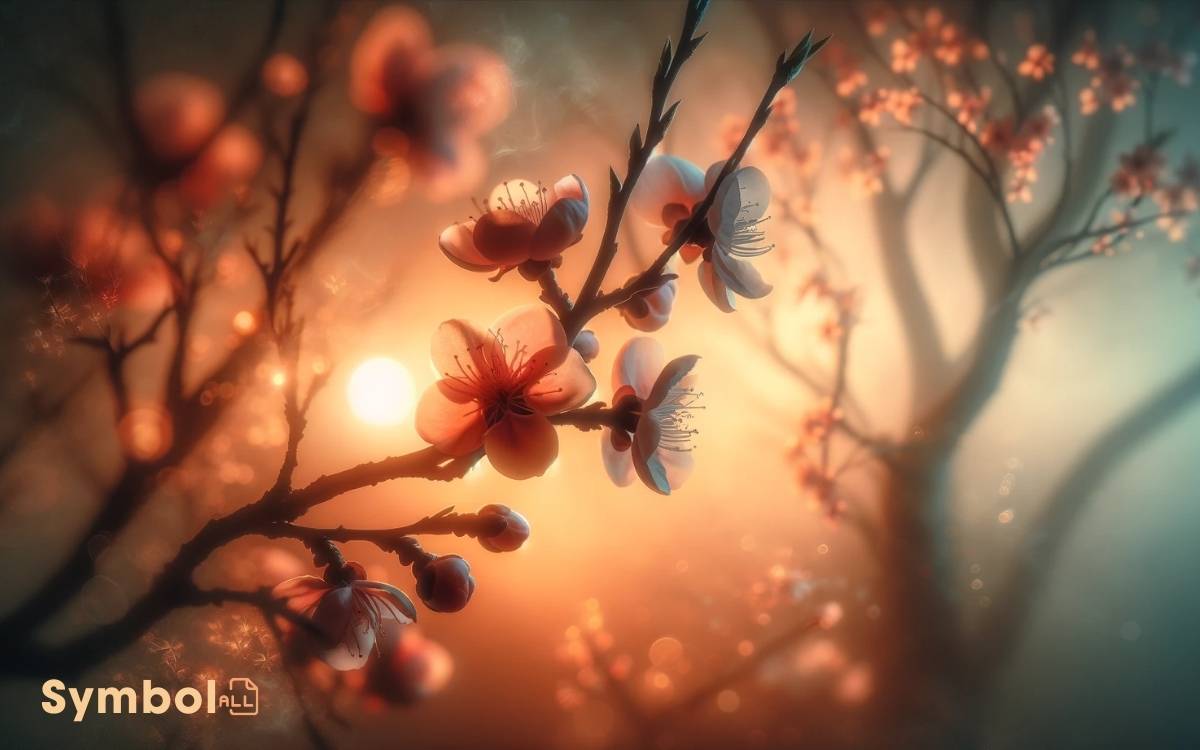What Does the Color Peach Symbolize? Immortality & Vitality!
The color peach symbolizes a complex interplay of immortality, vitality, and the gentle balance of existence. It embodies the eternal spirit, deeply rooted in ancient beliefs and cultural expressions.
In your exploration, you’ll find that different societies imbue peach with varied meanings, from Chinese associations of immortality to Western notions of modesty.
Emotionally, peach evokes warmth, comfort, and a sense of tranquility, boosting morale while fostering an environment of openness.
In fashion and design, it offers a fresh, inviting presence, signaling modernity entwined with timeless elegance.
Beyond its aesthetic appeal, peach resonates with profound symbolism in art and literature, blending passion with serenity.
This exploration offers a gateway into understanding the deeper implications of peach, illuminating its capacity to reflect the human experience’s diverse facets.

Key Takeaway
Historical Significance
Throughout history, the color peach has symbolized immortality and vitality, deeply rooted in ancient cultures’ beliefs and artistic expressions. Associated with the fruit of the peach tree, which was often linked to longevity in Chinese mythology, the color peach exudes an aura of life and renewal. This symbolism often stands in contrast to darker hues, leading many to ponder cultural interpretations of various colors, such as what color rose means death. By exploring these meanings, we gain a deeper appreciation for how color has served as a powerful language across different societies.
This hue, a blend of pink and orange, suggests a delicate balance between the warmth of life and the gentleness of existence.
In your quest for understanding, recognizing that the symbolism of peach isn’t only about its visual appeal is crucial. Instead, it reflects societies’ perennial quest to capture the essence of life and eternity in color.
Ancient artifacts and texts reveal that peach was often chosen to represent the eternal, the transcendent, beyond its immediate aesthetic pleasure.
This choice wasn’t arbitrary but a thoughtful selection, indicating a sophisticated understanding of color psychology and symbolism, where peach served as a metaphor for the everlasting, the undying spirit of humanity.
Cultural Interpretations
The cultural interpretations of the color peach vary greatly across different societies, each imbuing it with unique symbolic meanings that reflect their values and worldview. This color’s symbolism is as rich and varied as the cultures that celebrate it.
To deepen your understanding, consider these insights:
- In Chinese culture, peach is often associated with immortality and longevity, symbolizing the pursuit of a virtuous life.
- Western societies might view peach as a color of modesty and innocence, reflecting a more subdued yet optimistic outlook.
- Middle Eastern cultures may interpret peach as a color of hospitality and warmth, inviting a sense of community and open-heartedness.
These interpretations illustrate how a single color can encapsulate a spectrum of meanings, each resonating with the cultural ethos from which it emerges.
Emotional and Psychological Impact
Building on cultural interpretations, it’s important to ponder how the color peach influences our emotions and psychological state, offering a nuanced understanding of its impact on human behavior.
Peach evokes warmth and comfort, subtly lowering defenses and fostering an atmosphere of openness and vulnerability.
This gentle hue stimulates a sense of peace and tranquility, encouraging a softer, more compassionate interaction with the world around us.
Psychologically, peach can boost morale and optimism, as its soft vibrancy is inherently uplifting. It’s not just a color; it’s a medium through which we can access a more positive and emotionally enriched state of mind.
Understanding this impact allows you to harness the emotional and psychological benefits that peach color embodies, promoting a balanced and harmonious mental well-being.
Peach in Fashion and Design
In the domain of fashion and design, peach emerges as a versatile color, embodying both modernity and timeless elegance, appealing to a broad audience seeking a touch of softness and warmth in their aesthetic choices.
This nuanced hue offers a range of possibilities:
- Versatility: Peach pairs well with both pastels and deeper shades, allowing for dynamic color combinations.
- Emotional Resonance: It evokes a sense of comfort and serenity, aligning with spaces and outfits designed for relaxation and positivity.
- Trend Influence: Seasonally, peach finds its way into collections, often heralding a fresh, optimistic outlook on fashion and interior trends.
Understanding peach’s role in fashion and design reveals its capacity to subtly influence mood and setting, enriching the narrative of visual aesthetics with its gentle, inviting presence.
Symbolism in Art and Literature
Why does the color peach resonate with such depth in art and literature, often symbolizing a spectrum of emotions and states from innocence to warmth?
This hue, blending the serenity of white with the passion of red, creates a visual and emotional middle ground.
In literature, peach often heralds youth and vitality, a color that whispers of first loves and the blush on a young person’s cheek.
Artists, on the other hand, use peach to imbue their works with a sense of softness and vulnerability, inviting viewers into a more intimate, emotional space.
It’s this unique ability to convey both the purity of new beginnings and the glow of contentment that makes peach an enduring symbol in the creative world.
Conclusion
Fundamentally, the color peach acts as a soft whisper in a bustling world, embodying warmth, joy, and a gentle strength. It’s like the first light of dawn, promising new beginnings and nurturing compassion.
Across cultures, its significance weaves through the fabric of history, emotions, and aesthetics, enriching our understanding of beauty and humanity. In fashion, design, art, and literature, peach transcends mere color, becoming a symbol of subtle power and serene confidence.
Its nuanced symbolism invites deeper reflection, encouraging a closer examination of the hues that color our perceptions and experiences.






